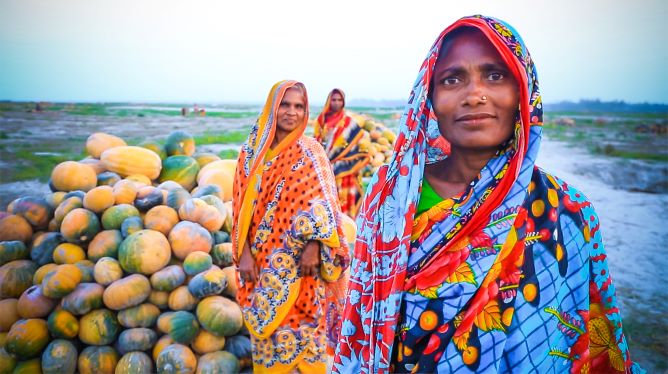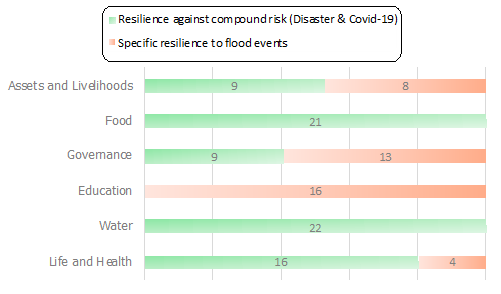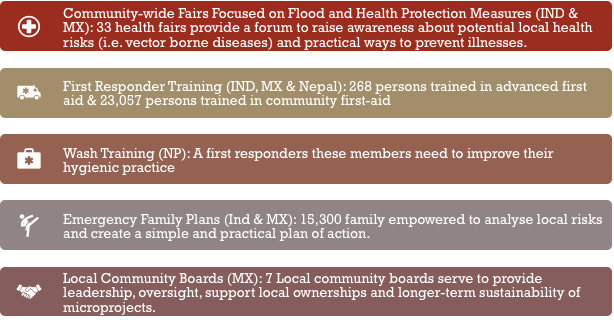In this blog colleagues from the Zurich Flood Resilience Alliance ask how we can and should support communities in preparing for, and building resilience to, events where the threat of infectious disease is compounded with floods and other disasters.
A systemic resilience view on COVID-19
The COVID-19 pandemic is fraying the social fabric of countries and communities across the globe. Interventions such as lockdowns, social distancing, and economic stimulus packages have been introduced to save jobs, shield the most vulnerable from the virus, prevent health systems from being overwhelmed and, ultimately, save lives.
The resilience of national health systems is particularly in the spotlight – primarily keeping occupancy numbers of intensive care beds under a critical threshold, as well as improving access to basic health services for people infected with the virus and ensuring that infections do not spread.
As pernicious as the global threat posed by COVID-19 is, there are many other threats, especially to poorer nations, including disasters and climate risks like flooding.
The monsoon season is imminent in Asia, and cyclones have already ravaged islands in the Pacific. The question is, how do we support communities in preparing for and building resilience to compound threats to live, like disasters and infectious diseases?

The Zurich Flood Resilience Alliance has been propagating a systems’ view on resilience. This means for a community or region to find measures that reduce risk of disaster, save lives and protect essential services like hospitals from damage or destruction while continue to pursue social, ecological and economic development goals .
In this article we argue that the international community, donors and wealthy nations must re-think how they invest in overseas development assistance, not to respond, in isolation, to a shock such as COVID-19, but with broader community resilience in mind. Our research with communities vulnerable to disaster shows that we can build resilience to compound shocks outbreaks concurrently, i.e. to floods as well as infectious diseases, especially when done alongside strategies to improve access to health, food and clean water.
The Alliance has built on this concept to inform community-led activities on flood resilience across the globe (for more on how this work supports resilience to COVID-19 read this blog). To inform intervention planning and implementation, the Alliance has also developed an innovative approach for measuring the various facets of what builds resilience against flood risk at community levels called the Flood Resilience Measurement for Communities (FRMC) measurement framework and tool that measures the various facets of what builds resilience against flood risk at community levels.
The FRMC is a holistic framework and an indicator-based assessment tool. It measures resilience before and after disasters at the community level – where people feel the impacts acutely and work together to take action to reduce risk to life, jobs and property. We define resilience widely in terms of a systems-thinking and development-centric conceptualization: “The ability of a system, community or society to pursue its social, ecological and economic development and growth objectives, while managing its disaster risk over time in a mutually reinforcing way.”
The FRMC measures resilience across a number of indicators (called sources of resilience) that are collected through humanitarian and development NGO Alliance partners and the IFRC in communities in Asia, Europe, Latin America, and North America. It provides vital information for decision-makers by prioritizing the resilience-building measures most needed by a community in terms of financial, human, natural, physical and social capital. At community and higher decision-making levels, measuring resilience also provides a basis for improving the design of public or privately funded programs to strengthen disaster resilience.
One of the seven themes that has been defined as a key aspect from the FRMC systems thinking approach is “Life and Health”, which is also relevant when looking at COVID-19 and includes access to and availability of healthcare facilities; strategies to maintain or quickly resume interrupted healthcare services; safety knowledge and Water and Sanitation (WASH).
Insights into dealing with COVID-19
In a recent research paper we analyzed FRMC data collected in 118 communities across nine countries in Asia, Latin America, and the US and explored which capacities or capitals contribute most to community disaster resilience. We identified multiple interactions, for instance, how action on bolstering health also contributes to social capital. There are two takeaways from this research that are relevant to other compound crises, including the COVID-19 pandemic.
First, through a so-called ‘multifunctionality’ effect, co-benefits are induced. This provides evidence of a virtuous cycle effect where higher resilient capacity in one area fosters communities’ resilience capacity for other functions. As community functions and outcomes are connected in a community system, improved access to health services can generate co-benefits (e.g., healthier individuals attain higher levels of livelihoods and build more social networks, which again build resilience during a shock). This has been well understood in the theoretical literature, and our analysis for the first time provides needed evidence at community level for flood and disaster risk. If these co-benefit effects are taken into account, we find evidence that Food and Water strategies (see Figure 1) can be most efficient in building resilience to both adverse flood and health events.

A second takeaway is that in the communities where the Alliance conducted FRMC studies, disaster resilience and the health component scored relatively low at the beginning. However, when interventions such as household health-related trainings in Mexico, or hospital capacity assessments in Nepal, were implemented (with our measurement tool running), the health component increased.
Lessons Learned
Fair and functioning (health) systems play a key role in building resilience against compound risk – against flood as well as against other stresses that lead to negative (health) outcomes. Strategies that enable interrupted (health) systems to quickly resume are critical and be in place before a disaster strikes.
Risk awareness is hazard-specific but can be integrated into packages that tackle risk generally. For example, health relevant interventions for infectious diseases (e.g., appropriate hygiene measures) can be integrated into flood evacuation plans. As a best-practice example from our work, campaigns and fairs have been carried out in Mexico and Nepal targeting educational awareness on health-related impacts during flood events among other options (see Figure 1).

This means that (further) accelerating investments into health services (e.g., as part of COVID-19 response and recovery packages) leads to additional benefits for other shocks.
Going forward with resilience thinking for implementation
There is growing recognition by research, policy-makers and practitioners of the need for addressing compound risks like floods and infectious disease outbreaks in a development-centric way, i.e. tackling multiple threats with a focus on human well-being, rather than addressing individual hazards exclusively. The COVID-19 crisis calls for donors, national governments, civil society and communities to invest in comprehensive and systemic approaches that create multiple benefits.
Our resilience research as well as implementation work with partners from civil society and the private sector, shows that utilizing a systems-based resilience assessment at community level can identify direct short-term and additional longer-term benefits. Targeted investments in capacities builds resilience against compound risks. Further investments into programs to ramp up health systems and WASH create multiple dividends in terms of both tackling COVID-19 and disaster risk simultaneously. In the context of the upcoming monsoon and hurricane season this means that COVID-19 response and recovery packages must plan for and include measures that also reduce social and economic impacts from COVID-19 triggered from flood (and other natural) hazards.
Our findings underline the need for greater ODA to increase (access) to health services to cope with COVID-19 as well as chronic exposure to disaster and climate risks. As well, diversifying household income strategies ranks high among the measures that unlock multiple co-benefits against compound risks. When COVID-19 moves from crisis response to recovery such measures should be part and parcel of any package that helps with coping and recovering from COVID-19 while reducing the livelihood risks of vulnerable groups.
This blog is adapted from a blog originally published by IIASA on 6 May 2020. You can read the original here.
Thank you to Michael Szoenyi, Ann Vaughan, and Ian Woolverton for support with the adaptation.

Comments